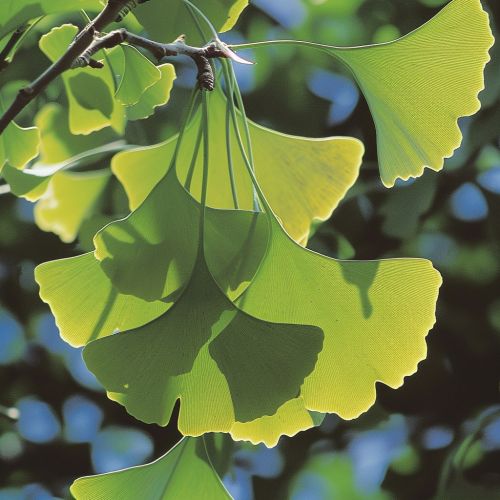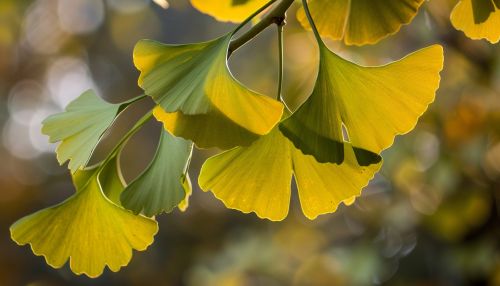Ginkgo Biloba: Difference between revisions
(Created page with "== Overview == <div class='only_on_desktop image-preview'><div class='image-preview-loader'></div></div><div class='only_on_mobile image-preview'><div class='image-preview-loader'></div></div> '''Ginkgo biloba''', commonly known as ginkgo or gingko, is a unique species of tree with no close living relatives. It is the only extant species in the division Ginkgophyta, all others being extinct. Ginkgo biloba is widely known for its distinctive fan-shaped leaves and is oft...") |
No edit summary |
||
| Line 1: | Line 1: | ||
== Overview == | == Overview == | ||
[[Image:Detail-92015.jpg|thumb|center|A close-up photograph of a Ginkgo biloba tree with its distinctive fan-shaped leaves.|class=only_on_mobile]] | |||
[[Image:Detail-92016.jpg|thumb|center|A close-up photograph of a Ginkgo biloba tree with its distinctive fan-shaped leaves.|class=only_on_desktop]] | |||
'''Ginkgo biloba''', commonly known as ginkgo or gingko, is a unique species of tree with no close living relatives. It is the only extant species in the division Ginkgophyta, all others being extinct. Ginkgo biloba is widely known for its distinctive fan-shaped leaves and is often referred to as a living fossil due to its long evolutionary history. The tree is native to China and has been cultivated for thousands of years for various purposes, including traditional medicine and as an ornamental tree. | '''Ginkgo biloba''', commonly known as ginkgo or gingko, is a unique species of tree with no close living relatives. It is the only extant species in the division Ginkgophyta, all others being extinct. Ginkgo biloba is widely known for its distinctive fan-shaped leaves and is often referred to as a living fossil due to its long evolutionary history. The tree is native to China and has been cultivated for thousands of years for various purposes, including traditional medicine and as an ornamental tree. | ||
Latest revision as of 14:41, 18 June 2024
Overview


Ginkgo biloba, commonly known as ginkgo or gingko, is a unique species of tree with no close living relatives. It is the only extant species in the division Ginkgophyta, all others being extinct. Ginkgo biloba is widely known for its distinctive fan-shaped leaves and is often referred to as a living fossil due to its long evolutionary history. The tree is native to China and has been cultivated for thousands of years for various purposes, including traditional medicine and as an ornamental tree.
Taxonomy and Evolution
Ginkgo biloba belongs to the division Ginkgophyta, class Ginkgoopsida, order Ginkgoales, family Ginkgoaceae, and genus Ginkgo. The species name "biloba" refers to the bilobed shape of the leaves. Ginkgo biloba is considered a living fossil because it has remained relatively unchanged for over 200 million years. Fossil records indicate that the ancestors of Ginkgo biloba were widespread during the Jurassic and Cretaceous periods.
Morphology
Leaves
The leaves of Ginkgo biloba are unique and easily recognizable. They are fan-shaped with a dichotomous venation pattern, meaning the veins fork repeatedly in two. The leaves are typically 5-10 cm long and broad, with a distinctive notch at the apex, giving them a bilobed appearance. The leaves turn a bright yellow in autumn before falling off.
Reproductive Structures
Ginkgo biloba is a dioecious species, meaning that individual trees are either male or female. Male trees produce small pollen cones, while female trees produce ovules. The seeds are enclosed in a fleshy outer layer, which emits a foul odor when ripe. The seeds are often referred to as ginkgo nuts and are used in traditional Chinese cuisine.
Distribution and Habitat
Ginkgo biloba is native to China, where it has been cultivated for thousands of years. It is commonly found in temple gardens and is considered sacred in some cultures. The tree is highly adaptable and can grow in a variety of soil types and climatic conditions. It is resistant to pollution and pests, making it a popular choice for urban landscaping.
Uses
Traditional Medicine
Ginkgo biloba has been used in traditional Chinese medicine for centuries. The leaves and seeds are believed to have various health benefits, including improving memory and cognitive function, treating circulatory disorders, and alleviating symptoms of dementia. Modern research has investigated these claims, with mixed results. Some studies suggest that ginkgo extract may have a positive effect on cognitive function, while others find no significant benefits.
Culinary Uses
The seeds of Ginkgo biloba, known as ginkgo nuts, are used in traditional Chinese cuisine. They are often roasted or boiled and added to dishes such as congee and soups. However, it is important to note that ginkgo nuts contain a toxin called ginkgotoxin, which can be harmful if consumed in large quantities.
Phytochemistry
Ginkgo biloba leaves contain a variety of bioactive compounds, including flavonoids, terpenoids, and organic acids. The most well-studied compounds are ginkgolides and bilobalide, which are unique to ginkgo. These compounds are believed to contribute to the potential health benefits of ginkgo extract. Flavonoids, such as quercetin and kaempferol, have antioxidant properties, while ginkgolides and bilobalide are thought to have neuroprotective effects.
Pharmacology
Ginkgo biloba extract is commonly used as a dietary supplement. It is standardized to contain 24% flavonoid glycosides and 6% terpene lactones. The extract is believed to improve blood flow, reduce inflammation, and protect against oxidative stress. However, the clinical efficacy of ginkgo extract remains a topic of debate. Some studies suggest that it may improve cognitive function and reduce symptoms of anxiety and depression, while others find no significant benefits.
Cultivation and Propagation
Ginkgo biloba is relatively easy to cultivate and is often grown as an ornamental tree. It prefers well-drained soil and full sun but can tolerate a range of soil types and environmental conditions. The tree is propagated by seeds or cuttings. Seeds require stratification, a process of cold treatment, to germinate. Cuttings are typically taken from young, healthy trees and rooted in a suitable growing medium.
Conservation Status
Ginkgo biloba is listed as an endangered species in the wild. The natural populations are limited to a few small areas in China. However, the tree is widely cultivated and is not at risk of extinction. Conservation efforts focus on protecting the remaining wild populations and preserving the genetic diversity of the species.
